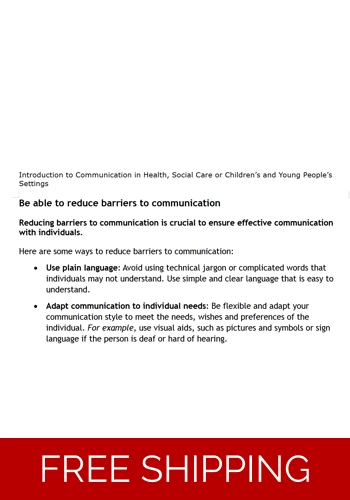Introduction to Communication in Health, Social Care or Children’s and Young People’s Settings
Introduction to Communication in Health, Social Care or Children’s and Young People’s Settings - Unit Resource - Handout number 3
27 page handout
Be able to reduce barriers to communication
Barriers to communication: background and culture of individual; sensory
impairment; dialect; use of jargon or language not appropriate to age/stage of
development; environmental factors e.g., noise, poor lighting; attitudes; effects
of alcohol or drugs; aggression; mental health problems; learning disabilities;
health conditions; lack of confidence
Ways to reduce barriers: use of technological aids; human aids e.g.
interpreters, signers, translators; using clear speech and appropriate
vocabulary; staff training; improving environment; reducing distractions
Checking understanding: e.g. asking questions to check understanding and
clarify, repeating and rephrasing when necessary, allowing adequate time for
response, awareness of body language and non-verbal communications of
respondent, visual clues and other signs that information has been understood
Sources of information and support: translation service; interpreting service;
speech and language services; advocacy services; third sector organisations
This handout covers every topic in the unit specification learning outcome 3.
HSC Training Link
Training Resources for Health and Social Care
Supplying training resources for the health and social care
sector since 2004.
Resources purchased are emailed to you via
Zip Folder attachment.
All packs are written in a generic style and can easily
be adapted to suit your own specific training delivery.
Resources are Microsoft Office based.
Secure payments via PayPal Merchant Commerce Platform.
You do not need a PayPal account to use this payment
gateway.
Debit and credit card payments accepted.




